2017 Superbike comparison: CBR1000RR, GSX-R1000R, YZF-R1, ZX-10R
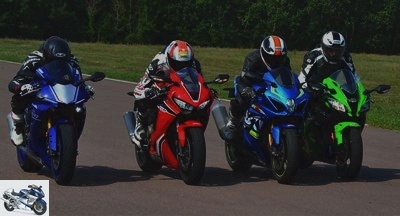
The 2017 vintage of Japanese hypersport motorcycles is exceptional: the sharp Kawasaki ZX-10R and Yamaha R1 are in top form, while the Honda CBR1000RR and Suzuki GSX-R1000 have finally returned to sport and technology.. Site contrasts these four thin 1000 cc blades on the road and on the circuit in an exclusive Superbike comparison on the web !
CBR1000RR, GSX-R1000R, YZF-R1, ZX-10R – Page 1: Static
The year 2017 will be a turning point in the rich saga of Japanese sports motorcycles as the Honda CBR1000RR, Kawasaki ZX-10R, Suzuki GSX-R1000 and Yamaha YZF-R1 once again level off at the forefront, for the first time since. about ten years! Forgotten the timid developments launched against the backdrop of the crisis, finished the models overtaken by Europe for lack of innovations: the Japanese quartet reinvests with force the "queen category" of production motorcycles, the one that makes every biker salivate at least once in his life !
- MNC test in Portimao (Portugal) – CBR1000RR (SP) 2017: neither gross nor submitted
- MNC test in Sepang (Malaysia) – ZX-10R: bigger for 2016
- MNC test at Phillip Island (Australia) – GSX-R1000R 2017: the beauty of Gex
- MNC test in Eastern Creek (Australia) – R1 and R1M 2015: with or without M, we like !
- MNC test : 850 km on the road with the 2015 Yamaha YZF-R1
If this return to the top converges perfectly today, it has however not been carried out at the same pace … Kawasaki has almost remained the grip in the corner since its first ZX-10R in 2004, while Honda and Suzuki have slowly but surely returned the hand until outright losing contact. So, while the "green bomb" was the first Japanese SBK to claim 200 hp – and traction control to manage them – in order to keep up with the BMW S1000RR and other Aprilia RSV4s, the Fireblade and the "Gex" were literally stalling technological.

As for the R1, its course is more tortured: the center of attention in 2009 thanks to its 4-cylinder "Crossplane" – crankshaft set at 90 ° as on the MotoGP M1 -, the Yamaha was then left behind. but without completely losing the suction … Because in the research centers of Iwata the ultimate weapon was being prepared: after having also been equipped with traction control in 2012, the R1 has been completely revamped in 2015, with a staggering power-to-weight ratio (200 hp for 199 kg) and Airbus electronics.
It was not until 2017, precisely, that Honda and Suzuki finally decided to graft anti-skating on their hyper sporting flagship, no less than eight years (8 years !!!) after the S1000RR, the first SBK to adopt it. standard in 2009! Incidentally, both have reactivated their subscription to the gym to hunt fat and gain muscle: the new CBR1000RR develops 12 additional hp (192 hp instead of 180) and weighs only 196 kg, i.e. 15 kg less than in 2016! A great way to celebrate the 25 years of this legendary lineage.
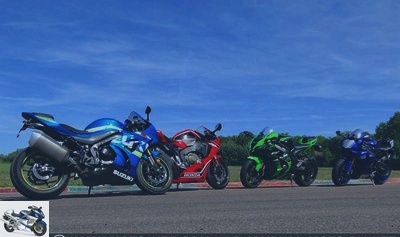
Same program for the sixth generation of GSX-R1000 (the first dates back to 2001): with its unprecedented variable valve timing, the 2017 "Gex" goes from 185 to 202 hp (+17 hp) and becomes the most powerful Japanese Superbike! And if its weight drops "only" by 3 kg (from 205 to 202 kg), its geometry is radicalized: reduced to 23 ° 2, its caster angle is as closed as the new Honda. The two novelties for 2017 put the package to shine on the track, even if it means leaving behind their reputation as a sportswoman who can be frequented on a daily basis….
This also translates into ultra-short sockets (95 and 96 mm respectively), to be compared to the 24 ° and 102 mm of the very incisive R1 (unchanged since 2015, except for its transition to Euro4 last year) and especially to the 25 ° and 107 mm of the Ninja deeply revised in 2016. The "Zak" therefore leaves with a handicap, all the more marked as its wheelbase is the most important (1440 mm against 1410 for the GSX-R and 1405 for the R1 and CBR) and its highest weight with 206 kg. That is 10 more than the Honda !
Honda and Suzuki switch from Minitel to the latest smartphone !
Like the Fireblade, the latest from Suzuki has taken to computing to catch up with the lead taken by the R1 and the ZX-10R: the sensitivity of the ABS and the traction control of these four motorcycles now varies according to the data collected by an inertial unit (IMU), which continuously measures their position on several axes (inclination, attitude, roll, etc.). All also offer several configurable maps, in order to vary their mechanical reactivity from the handlebars (see table "Equipment" on page 7).
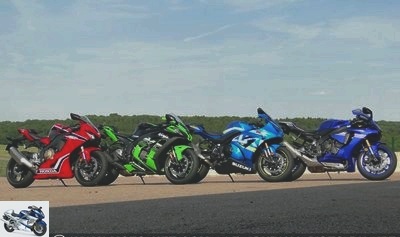
Three of them (Honda, Kawasaki and Yamaha) are equipped with engine brake control, thanks to which this parameter can be accentuated or attenuated according to taste and practice. Set to the lowest on the circuit, this feature is very interesting because it prevents the pilot from the effects of engine inertia during the "braking-downshifting" phases. Its absence on the Suzuki is all the more detrimental – on track – as its engine brake is the most important with that of the Yamaha.
To simplify the handling of all these electronic crutches, pre-recorded driving modes are installed on the Fireblade and the R1: just change the mode to intervene at once on all assistance (from the most intrusive to the most permissive ). Initially complex to grasp, these modes turn out to be valuable allies as soon as their handling is assimilated, which occurs quickly thanks to the logical arrangement of Honda and Yamaha instrumentation..
On Kawasaki and Suzuki, changing the mapping or traction control sensitivity requires first selecting and adjusting the desired parameter, then starting over with the next one. Not enough to put the spleen in court bouillon, but it’s easier to sharpen or soften the reactions of the R1 and CBR by simply scrolling through their modes from the left commodo. Not to spoil anything, these modes are configurable at will in order to shape a "motorbike in your hand".
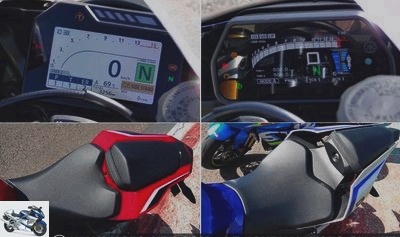
We appreciate at this moment the TFT matrix screens in Honda and Yamaha colors: real tablets, moreover readable and suitably supplied (see). The Kawasaki’s monochrome digital screen, quite busy and austere, is getting a bit old in comparison! Its light diodes responsible for indicating the engine speed are also variously appreciated: some praise their visibility, others point to a very flashy presentation, limit Christmas garland … A matter of taste.
Ultimately, MNC prefers the instrumentation of the GSX-R1000, admittedly less "high tech" and flashy than its rivals CBR and R1, but more complete and easy to read even with the sun behind your back. The Suzuki is for example the only one to provide the fuel level: this precious information is however not useless with regard to the low tank capacities (17 liters on the ZX-10R and the R1, 16 on the CBR and the GSX -R) and consumption that can quickly increase.
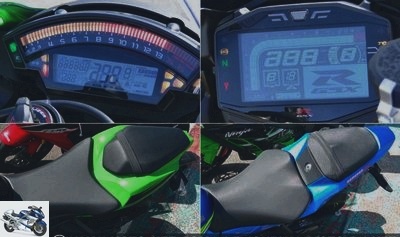
If the Honda was satisfied with a very sober 6.6 l / 100 km on average during this comparison (road and track consumption mixed), the Yamaha for its part used the 8 liters (7.87 l / 100 km ), while the Kawasaki and Suzuki barely stayed below the 7-liter mark (6.98 and 6.85 l / 100 km respectively). Note that MNC has covered almost five times more distance on the road than on the circuit: around 115 km of track out of a total of 550 km (see conditions and route in the right column).
Cutting-edge equipment and materials
The R1, ZX-10R and GSX-R1000R are also equipped as standard with a shifter, an essential accessory for grabbing time on the track and resting the left wrist on the road because it allows you to change gears without disengaging. Note, however, the additional "R" at the end of the Suzuki name, which designates its top-of-the-range version: the "Gex" 2017 is indeed devoid of shifter in standard configuration (GSX-R1000 "short").

For the sake of fairness, MNC originally planned to oppose the Japanese Superbikes in their most accessible version, but Suzuki France was unfortunately not able to meet our request: it is therefore the "R" at 19,399 € which rubbed shoulders with the standard CBR1000RR, ZX-10R and R1, respectively displayed at € 17,999, € 17,899 and € 18,999. Technically advantaged, the GSX-R1000R in return becomes the most expensive of the four, while it would have been the cheapest in this comparison in basic configuration (€ 16,599).
And concretely, what does this suffix "R" change? The Suzuki wins in particular excellent Showa suspensions with external cylinders – the same as the ZX-10R – and a bidirectional shifter (up and down without disengaging). Not insignificant advantage compared to the "single acting" systems of the ZX-10R and the R1 … and the pure and simple absence of shifter on the standard CBR1000RR (present on the SP and SP2 versions)! Frankly stingy from Honda, as well as the original tires a notch below: Bridgestone S21 against RS10 for its rivals.
The Honda also lends itself to criticism because of its rubber hoses which actuate its Tokico radial calipers. The Suzuki is also devoid of braided elements on its Brembo calipers, while Yamaha pretends: only its front calipers are solicited by aviation hoses! The ZX-10R has everyone agree with these splendid Brembo monobloc M50 calipers and braided front-to-rear hoses. A device worthy of a high-end Italian hypersport !

The "Fire Blade" however corrects the shot with its high-end finish, whether in terms of surface treatments (class, the golden lower casings!), Screws or the integration of cables and hoses. The head of its Showa shock absorber integrated into the swingarm also demonstrates a real concern for integration and aesthetics. The ZX-10R, in addition to being very attractive thanks to its "Racing" peripherals, is just as neat.
The Suzuki is the least convincing in this area: the welds of its rear frame of square section and its engine screws are arbitrary, while the water pump and its hoses are exposed to view under the left crankcase. As for the Yamaha, if the eye blinks in front of the small jumble of hoses above the right footrest created by its central coupled ABS (front-rear), it widens in front of everything else !
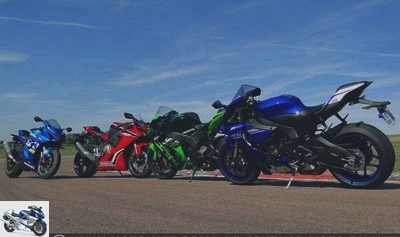
In addition to its sculptural line, the most distinguished and original by general opinion, the Yamaha is full of noble materials: aim a little for its rear buckle and its magnesium rims (a first on a production motorcycle), its cylinder head cover and its oil pan made of the same precious material or its 43 aluminum engine screws! Another exceptional piece: its aluminum tank, while those of the CBR, ZX-10R and GSX-R are made of steel.
Yamaha has spared no effort to lighten its R1 as much as possible and make it a true replica of a racing motorcycle! This daring and attractive approach explains its high price – the highest of the four in the standard version – and according to MNC legitimates its first place in our "static" ranking (see all ratings and rankings in).
- Continuation of our Superbike comparison with our dynamic part on the road in, then on the circuit in !
Related articles
-
2017 Superbike comparison: CBR1000RR, GSX-R1000R , YZF-R1 , ZX-10R The 2017 vintage of Japanese hypersport motorcycles is exceptional: the sharp Kawasaki…
-
2017 Superbike comparison: CBR1000RR, GSX-R1000R , YZF-R1 , ZX-10R The 2017 vintage of Japanese hypersport motorcycles is exceptional : the sharp…
-
2017 Superbike comparison: CBR1000RR, GSX-R1000R, YZF-R1, ZX-10R The 2017 vintage of Japanese hypersport motorcycles is exceptional: the sharp Kawasaki…
-
2017 Superbike comparison: CBR1000RR, GSX-R1000R , YZF-R1 , ZX-10R The 2017 vintage of Japanese hypersport motorcycles is exceptional: the sharp Kawasaki…
-
2017 Superbike comparison: CBR1000RR, GSX-R1000R, YZF-R1, ZX-10R The 2017 vintage of Japanese hypersport motorcycles is exceptional: the sharp Kawasaki…
-
Comparison test Kawasaki Z900, Suzuki GSX-S750 and Yamaha MT-09: Election of the best Japanese maxi-mid-size roadster In 2017, Kawasaki further…
-
Honda CBR1000RR / SP 2017 test: neither gross nor submitted ! Forget the old CBR1000RR lacking in performance and technology: Honda celebrates 25 years…
-
2017 Superbike comparison: CBR1000RR, GSX-R1000R, YZF-R1, ZX-10R The 2017 vintage of Japanese hypersport motorcycles is exceptional: the sharp Kawasaki…
-
2017 Suzuki GSX-R1000R review: the beauty of Gex Driven by the most recent hypersport motorcycles for lack of developments over the past ten years or so,…
-
Comparison test Kawasaki Z900, Suzuki GSX-S750 and Yamaha MT-09: Election of the best Japanese maxi-mid-size roadster In 2017, Kawasaki further…